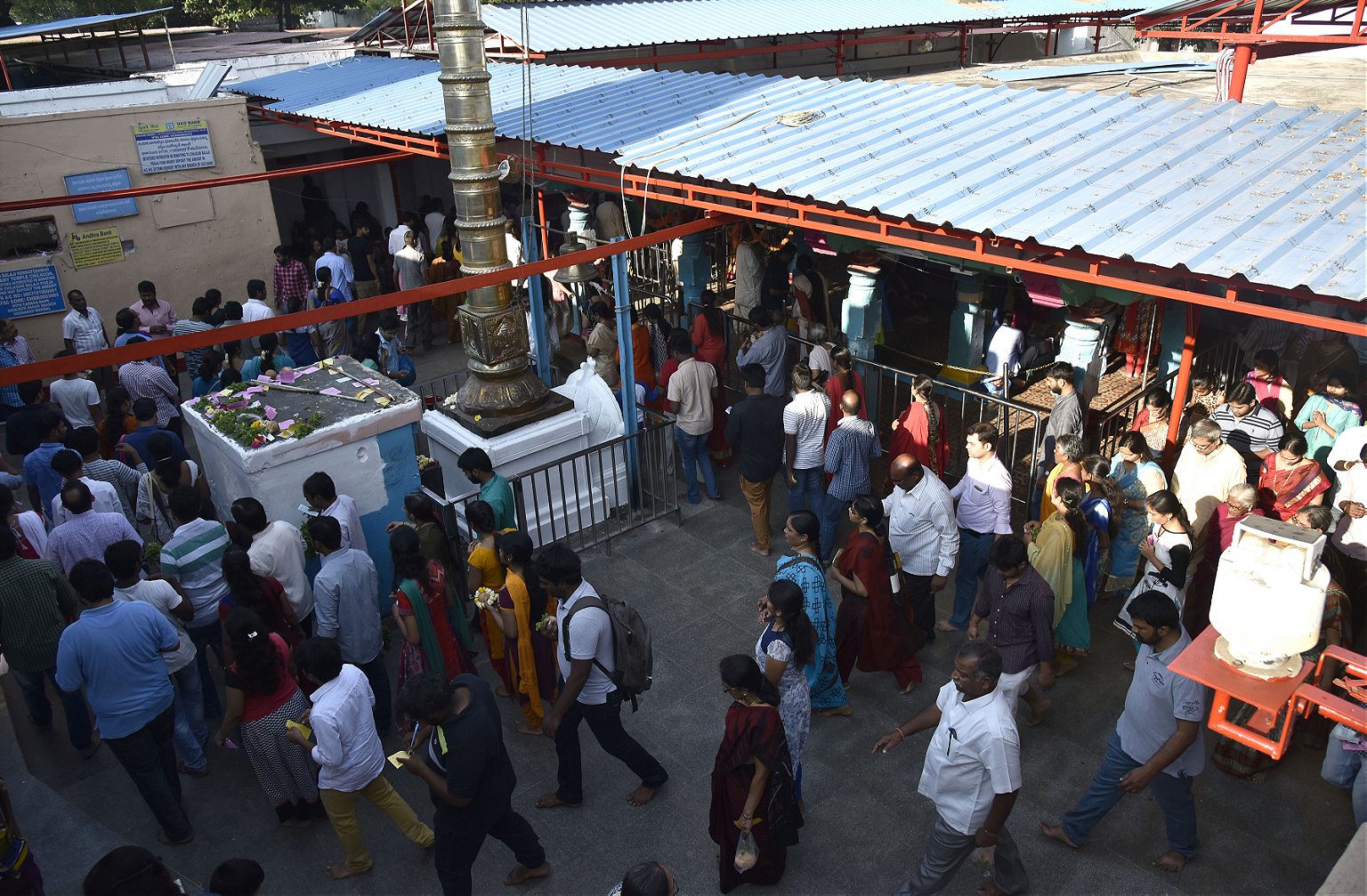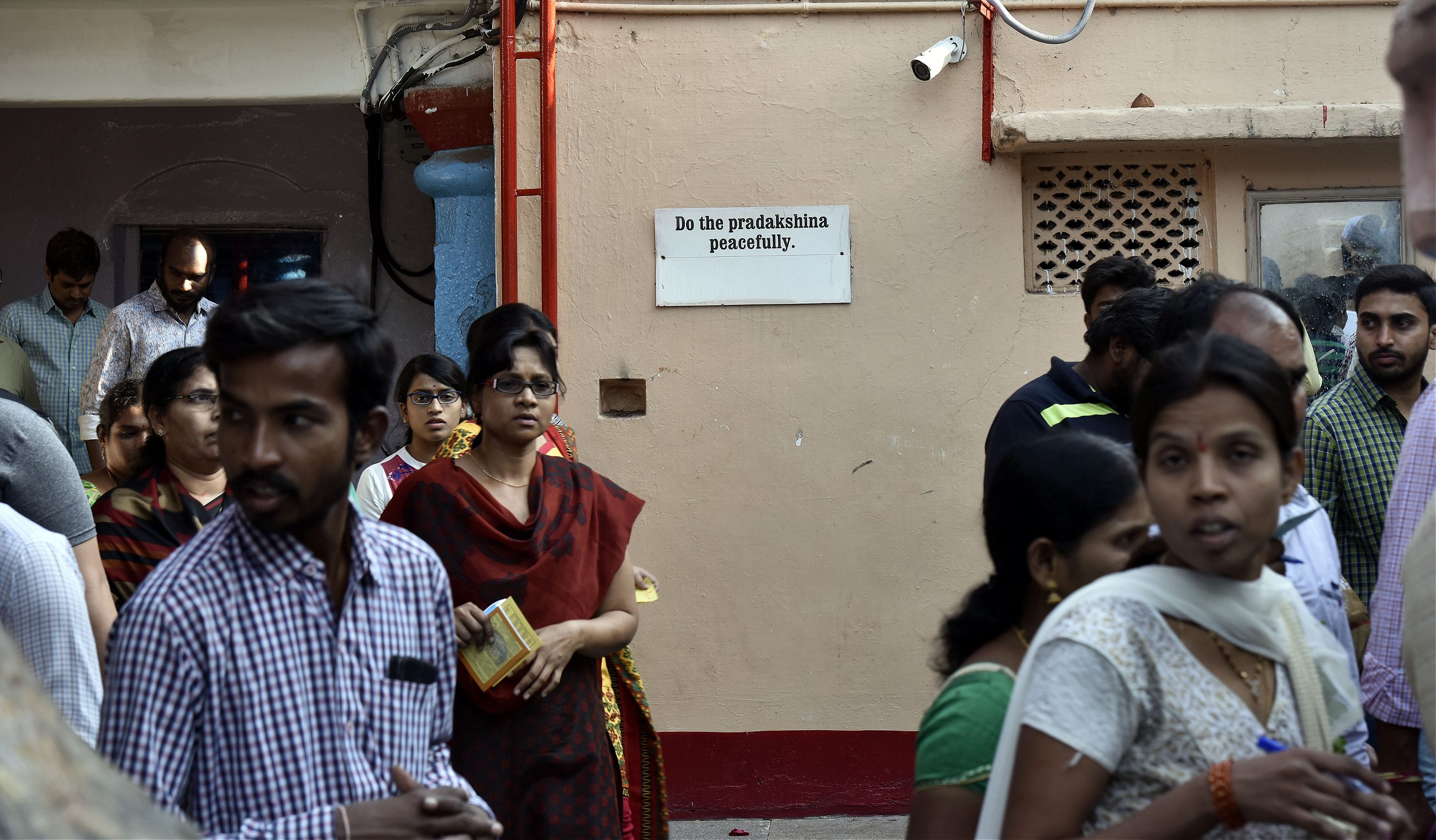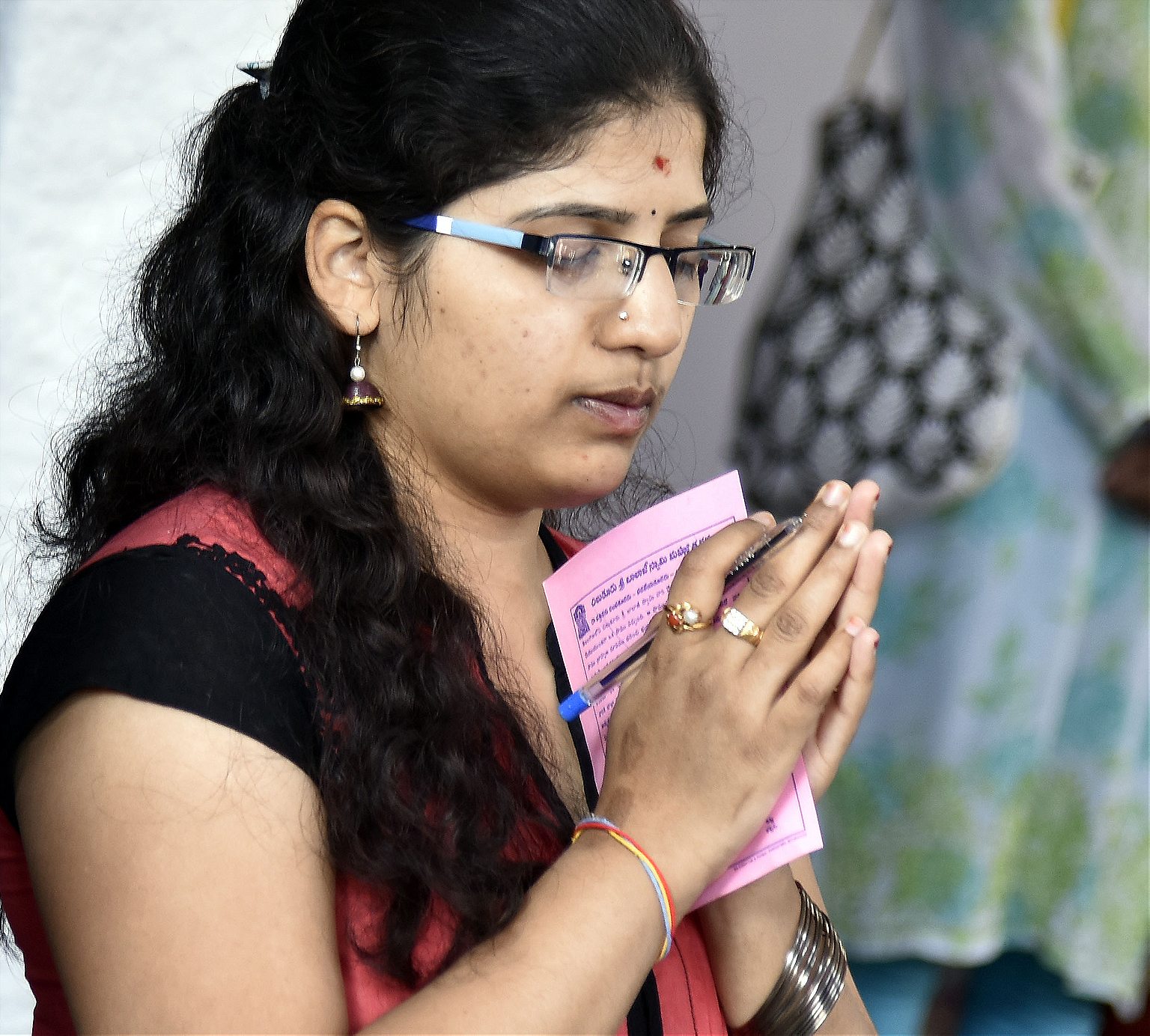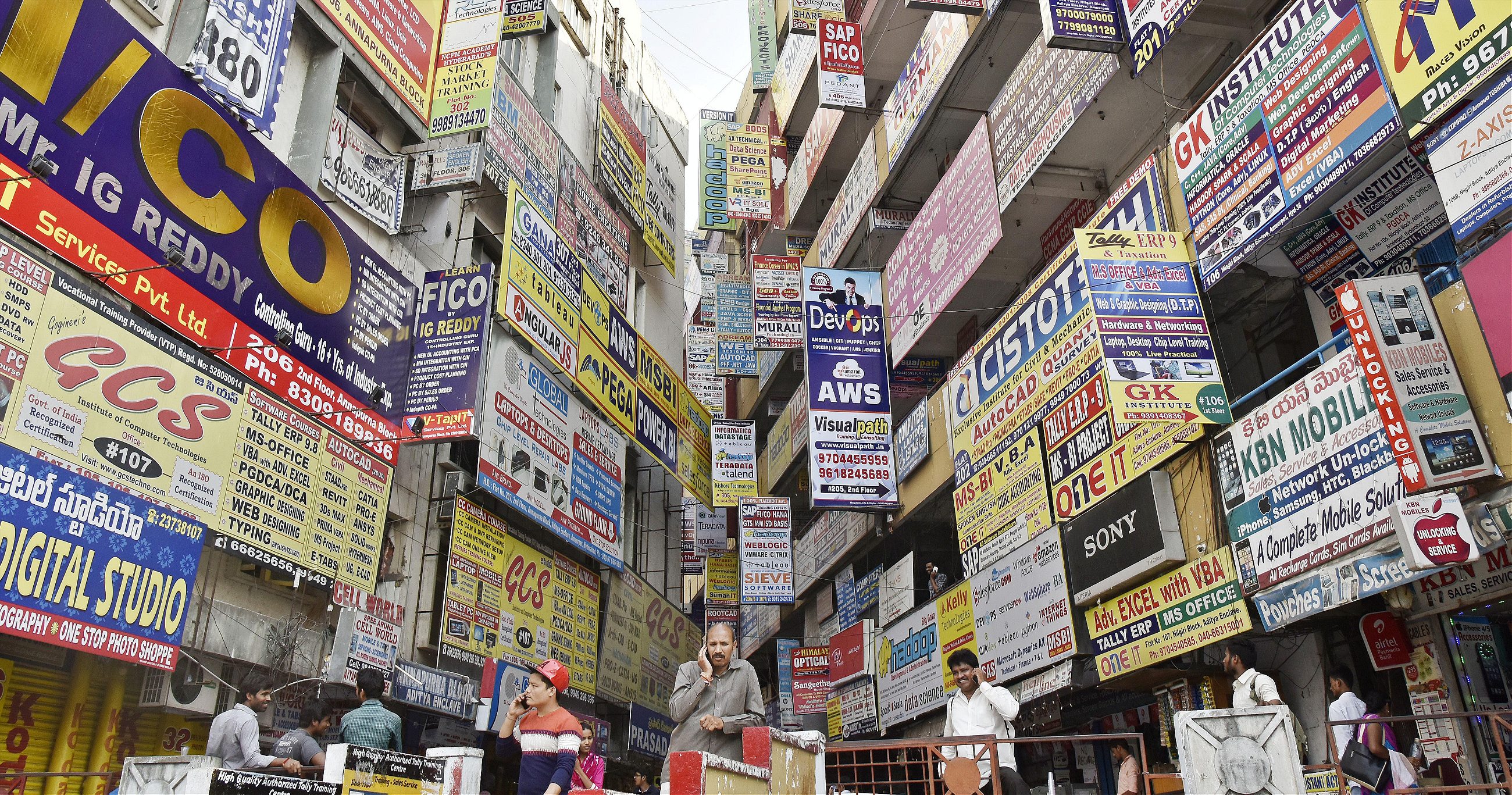Indians are still praying for the chance to come to the U.S., even in the age of Trump.
HYDERABAD, India—
Leaning into the microphone to address his audience, C.S. Rangarajan, the bearded head priest of the Chilkur Balaji temple, squawks, “Our Bhagwan (God) is greater than Donald Trump!”
Welcome to the Visa Temple.
For decades, young people from across India have flocked to this 500-year-old structure on the outskirts of Hyderabad, India’s fifth largest city, with a shared dream: a visa to the United States. The temple, formally known as the Chilkur Balaji, is middling in size by Indian standards but, as its endless crowds suggest, its incarnation of Vishnu grants wishes at a rate that is anything but average.
Rangarajan is addressing the morning’s temple goers who, like a school of fish, circumambulate the temple’s inner sanctum chanting the Hindu deity Balaji’s name in vague unison. Crumpled in most people’s hands are pink slips of paper with 108 numbered boxes used to count the number of pradakshina, or rounds, that they make. It is said that if you complete 11 orbits around the inner shrine, Balaji will smile down on you. If he does, ritual dictates that you come back and make 108 rounds.
On a Saturday morning, a cluster of college-age women in sequined red-and-green ghagra choli jostle around a selfie stick in the parking lot. By the temple, a dozen empty shacks advertise identical menus of oily South Indian breakfasts while a gauntlet of hawkers invite passing visitors to buy coconuts, flower garlands, and other offerings for the god.
“After I came here, the very next day I got a call to submit my passport,” says Arjun Majumdar, a systems analyst who is all smiles with four friends outside the temple grounds. He tells me—with an almost palpable sense of triumph in his voice—that his work visa to the U.S. had been put on hold for more than three months due to a minor paperwork issue. After his visit to Chilkur, it was approved in just three days.

Just how did the Chilkur Balaji Temple become a consular pit stop for faithful Hindus? According to Rangarajan’s telling, in 1983, a priest started circling the temple as a customary appeal to god after the nearby lake dried up. After 11 rounds, water reappeared in the lake, so the priest continued walking, completing 108 circles to express his gratitude. Around the same time, a group of engineers—a resource in endless supply in Hyderabad, a major tech outsourcing hub—was visiting the temple and learned about the priest’s special connection with God. The engineers followed suit and made 11 rounds of their own. Shortly after, they bagged visas to study in the U.S.
While visas are not the only thing that draw people to Chilkur Balaji—some come with marriage wishes, others to clear debts—on any given day, the temple swells with well-dressed young men and women clutching their passports in prayer.
In 2016, the U.S. consulate in Hyderabad issued 169,071 nonimmigrant visas, which grant foreign students and workers temporary stay in the United States. The number rose by more than 15,000 from the previous year. In comparison, for all six countries currently on Donald Trump’s revised travel ban, 53,440 nonimmigrant visas were issued.
For many Indians watching last year’s presidential election, the focal point was news about high-skilled immigration to the United States. On the campaign trail, Donald Trump had promised that he would dramatically shrink skilled immigration as part of his larger anti-immigration agenda. His “America First” policies would attack the system’s very backbone: the H-1B, a renewable three-year visa issued to skilled foreign professionals like software developers, computer programmers, and college professors—and the vehicle through which millions of Indians have migrated to the United States. It’s these visas that inspire the prayers at Chilkur Balaji.
“I will end forever the use of the H-1B as a cheap labor program and institute an absolute requirement to hire American workers for every visa and immigration program,” Trump said in March.
According to his believers, the god Balaji delivers no matter who is in the Oval Office
In January, alleged drafts of multiple executive orders which would restrict how employers hired H1-B workers and foreign students were leaked, triggering wild speculation in the Indian media. Within days of taking office, it seemed like the Trump administration would threaten the extinction of global outsourcing giants like Tata Consultancy Services and Cognizant Technology Solutions, which place tens of thousands of foreign software professionals (most of them Indian) in the American tech industry each year.
But according to his believers, the god Balaji delivers no matter who is in the Oval Office.
“Our children are not liabilities but assets to the United States!” Rangarajan booms. “They are not refugees or illegals. They go there with work permits, with visas!”
A former biomedical engineer, Rangarajan abandoned his career to serve the Chilkur Balaji temple for the same reason as most Hindu priests: because of hereditary obligation. He chuckles when I immediately mention Trump and his anti-immigration politics.
“See all these devotees,” Rangarajan says, pointing to over half of the room who, on cue, raise their hands. “All of them have gotten U.S. visas. After Donald Trump won.”

For now, Rangarajan might be right. The H1-B pledge has been put on the backburner as Trump’s administration has focused more of its attention on preventing unwanted arrivals from the Middle East and Mexico. But the current political atmosphere in the United States has affected Indian immigration in another way.
Thirty-two days after Trump’s inauguration, Srinivas Kuchibotla, an Indian immigrant from Hyderabad, was shot dead at a bar and grill in Olathe, Kansas. He was drinking a Jameson with his friend, Alok Madasani, also an engineer from south India in his early 30, when Adam W. Purinton, a 51-year-old retired Navy veteran, approached the two men and demanded to know whether they were legal residents of America. Madasani, who was also injured in the attack, told police that Purinton left the bar and returned with a gun. Before opening fire on them and another bar patron, he yelled, “Get out of my country!”
On March 2, another Indian man was killed in the U.S. This time, Harnish Patel, the 42-year-old proprietor of Speedee Mart, a convenience store in South Carolina, was shot outside his house after returning from work.
Then, in Washington state, less than 48 hours later, a masked gunman shot Deep Rai, a Sikh American of Indian origin, after shouting, “Go back to your country!” Raj survived the attack but his assailant’s words started to sound like a morbid refrain to Indians following the news from home.
“There is some uneasiness now, definitely,” says Srinivas Dhavala, a retired government employee in Hyderabad with two children living in the U.S. on nonimmigrant visas. “Maybe more for us because we are so far away. What can we do, though?”

In the Visa Temple, where devotees leave their shoes, phones, and purses at the door before prostrating to Balaji, the string of attacks seem to strengthen people’s appeals to God. Rangarajan expresses a cautious optimism.
“Our Balaji is protecting entire world,” he explained when I visited the temple in early March. “We are praying that he changes the mindset [of others] so these things don’t happen.”
Rangarajan looks every bit the austere Hindu priest with just a hint of Joe Pesci mixed in. He greets those who approach him with an easy sincerity and speaks in a raspy, high-pitched voice. He is stocky and bald, aside from the traditional sikha, a small tuft of hair that Hindu priests grow at the rear of the head, and is known as a priest who cracks jokes in a medley of languages (he speaks five) alongside the more serious stuff. As far as I could tell, neither the temple’s materialist raison d’être nor its peculiar fame (he has had numerous visits from the international press) fazes him.
“The CNN woman was a smart girl!” he said, again to the entire temple, of a recent visitor. “She asked me why I do my job when the U.S. consulate is working here in Hyderabad. I told her, ‘Even the U.S. consulate is working under Lord Balaji!’ And see, because of Balaji, his speech in Congress was a little better,” he said, referencing Trump’s joint congressional address in late February.
Amazing. A poster in Hyderabad congratulates one Chinna Reddy for succesfully getting his US visa. (Via Facebook) pic.twitter.com/KFEJNS2gRq
— Vivek Nemana (@vnemana) May 9, 2015
To grasp the import of IT and software in Indian cities like Hyderabad or Bangalore, hail a rickshaw to any number of neighborhoods where “coaching centers” or test-prep schools reside. The Hyderabadi neighborhood of Ameerpet, for one, welcomes passersby with a surreal blizzard of advertising. Thousands of clashing signboards and banners cover old buildings and begrimed streets, offering an unreal range of test-prep courses: GRE, GMAT, IELTS, TOEFL, LSAT, SAT, and technical certifications for programming tools like Java, C++, MATLAB, and others. (The awe-inspiring displays can double as a valuable introduction to the special relationship that Indians have with acronyms.)
In Ameerpet and neighborhoods like it, an ecosystem of education-oriented business flourishes: single-sex dorms, towering bookstores, spoken English institutes, and education consultancies that help Indian students study in the U.S. and a number of Commonwealth countries.
I wait to meet the director of one such consultancy in an empty lobby that is mysteriously lit neon green. In the middle of the room sits an outsize fish tank that adds a touch of ’90s Bollywood to the small office space. Framed flags of the United States, Britain, Australia, Ireland, Canada, and New Zealand grace the walls along with a few trivia points about each country.

“Many students are not applying to the U.S. as of now,” the education consultant tells me in his office. “Most people are on hold, waiting for [Trump’s] declaration, or they are looking for some other option in Australia, Ireland or somewhere else.”
He is quick to admit that if some of the proposed changes to high-skilled immigration take effect—specifically, an increase to the minimum salary of H-1B workers to $130,000 per year—he, too, might eventually be out of work.
Most high-skilled workers on the H-1B earn salaries close to the current minimum of $60,000. Changes to the H-1B system will no doubt arrive slowly, in large part because of the tech industry’s intense lobbying against immigration reform that hurts it, but the effects of leaving hundreds of thousands of techies in the lurch in Hyderabad loom large.
“We are helpless in that case,” the director says. “Everybody will be shaken. My job security, shaken.”
I recall what Rangarajan told me as I left the Visa Temple earlier in the afternoon.
“Balaji is permanent. Donald Trump is not.”
Top image: C.S. Rangarajan, head priest of the Chilkur Balaji, greets the day’s visitors.
